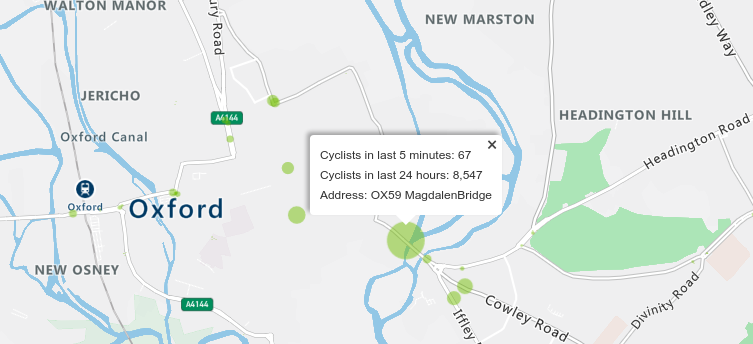Oxford's Magdalen Bridge is plausibly the second busiest cycle route and the busiest bus route in the United Kingdom; it is also a major pedestrian route. It is probably the most critical link in the city's transport system.

When data from it was available, the Vivacity counter on Magdalen Bridge occasionally showed over 9,000 cycle movements a day. And I was at a Vivacity demo, on a Tuesday in November 2021, where the dashboard showed that 415 cycles had gone over the bridge in just fifteen minutes in the morning peak! Numbers are significantly lower outside term-time, however, so the yearly totals will be under two million. London's Cycle Superhighway 3 (the East-West route along the Embankment) is clearly busier, peaking at over 10,000 cycles a day and moving over two million cycles a year, but CS6 at Blackfriar's Bridge only reached 1.135 million cycle movements in 2020. I don't know of any busier routes, so Magdalen Bridge is plausibly the second busiest cycle route in the UK. And similar numbers of people walk across the bridge, probably more on average than cycle.
Magdalen Bridge also carries around 2000 buses a day and around 200/hour in peak. (The Vivacity counter sometimes topped 2000 in a day and Robert Weetman reported a manual count of 198 buses in an hour on High St, which misses the 12 local buses an hour on Longwall.) London's Oxford Street used to carry 270 buses per hour, but that was reduced by 40%. The busiest route outside London may be the Wimslow Rd bus corridor in Manchester with at least 120 buses/hour. ("The half mile stretch of route in the city centre between the RNCM and Oxford Road station has a timetabled average of nearly a bus every 30 seconds in each direction.") So Magdalen Bridge is plausibly the busiest bus route in the entire country!
Magdalen Bridge remains a major barrier to sustainable transport, however. The problem is not the bridge itself, where the "over-allocated" cycle lanes work pretty well given the space constraints, but rather the junctions at either end, the Plain roundabout to the east and the Longwall-High junction to the west. Congestion at these junctions delays buses, and both junctions are hotspots for cycling collisions as well as deterring many people from cycling over Magdalen Bridge at all. (I have lost track of the number of competent adult cyclists who have told me they simply won't cycle through the Plain, and I myself have only ever cycled it with my 8 year-old on Sundays, and even then only northbound from Iffley Rd to the bridge, which is the easiest movement.)
Magdalen Bridge should be prioritised as a foot, cycle and bus route by removing private motor traffic. This was being contemplated as far back as 1975 and was envisaged as part of Connecting Oxford, but I think traffic reduction here is more important than elsewhere. Restrictions should be in place 24/7 and a bus gate should be located on St Cross Rd or Longwall rather than South Parks Rd, to minimise access traffic needing to use Longwall. (This is apparently Oxford University's preference too, allowing the entire science area and most of the collages to be accessed from the north.) There should also be a bus gate on St Clements, to stop the Plain being part of a through route from East Oxford to Marston or Headington. [Update: a month after I wrote that, the county announced "transport proposals to achieve a zero carbon transport network", with the bus gate moved to St Cross and with the additional bus gate on St Clements.]
The key is to reduce traffic enough to allow for the junctions to be redesigned. Plans for making the Plain accessible to cycling were scotched because of bus company concerns over delays, but in the absence of other motor traffic that will be less of a concern. The Longwall junction needs to work without a separate right-turn lane for motor traffic, which would free up space for a cycle lane, for cycles waiting to turn, and for wider pavements. The pinch point just west of the junction will remain and, with just 12m total width available, mixing motor traffic (buses and taxis) with cycles here may be unavoidable. But traffic could be reduced by time-restricting service/loading access and making the High St bus gate operate all day. And with Longwall carrying just buses, taxis and tiny amounts of access traffic, the narrowest pinch point there could operate with alternating traffic lights and a single traffic lane, or in a similar way to Queen St, with motor traffic doing 5mph.
